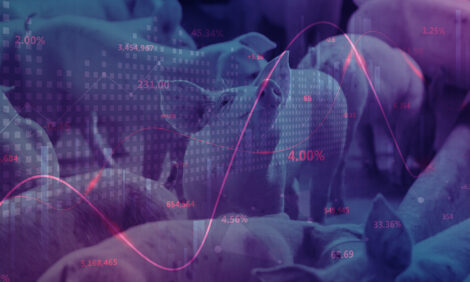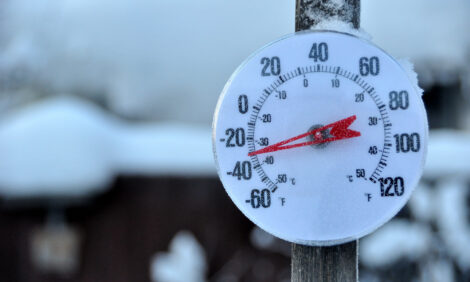



UK/EU Pig Statistics - October 2005
This article provides an overview of the latest statistics relating to pigs in the UK and Europe and includes Slaughter figures, Carcase weights, Pigmeat production, trade and supplies and UK and EU Prices and value of pigs. Extracted from the quarterly pig bulletin published by Defra.
For the purpose of this notice, the 10 newly acceded EU states are still shown as candidate countries due to the lack of available data for the main pig statistical categories. These countries will be transferred and included within the EU data when figures become available.
1. Pig slaughterings
The graph below illustrates the trends in the monthly results and the average weekly
slaughter:

In the nine months to September 2005 slaughtering of clean pigs were 1% higher than for the
same period in 2004.
In 2004 9.1 million clean pigs were slaughtered in the UK, just slightly higher than the total
seen in 2003 after taking into account the 53 week statistical year in 2004, thus confirming the
annual decline appears to have slowed right down, with July 2004 been the first month (other
than in one FMD-distorted month) that there was not a decline in slaughtering since 1998.
When converted to a 52-week basis, there were 8.951 million pigs slaughtered in 2004 this
was again lower (-2%) than the previous year.

Sow and boar slaughterings for the period January to September 2005 were 10% lower than in the same period in 2004. In 2004 sow and boar slaughterings (at 239 thousand head) remained virtually unchanged when compared with 2003, after taking into account the 53 week statistical year. When converted to 52-statistical year, sows and adult boars were down 6 thousand head on 2003 totals.
Disease Outbreaks
During the period February to September 2001 slaughterings were affected by the Foot and Mouth disease outbreak over the period 149,000 pigs were slaughtered following confirmation of disease or as dangerous contacts. A further 287,000 pigs were slaughtered under the Welfare Disposal Scheme. None of these pigs are counted in the slaughterings in Tables 1 and 2 above, nor used for meat production.
EU pig slaughterings
Numbers of EU pig slaughterings are only available in total, as the statistical legislation does
not require Member States to differentiate between clean and cull slaughterings.
In 2003 most producing member states (except France, the Netherlands and the UK) showed
increases in slaughterings. In 2004 overall slaughterings in the EU 15 remained virtually
unchanged, with Spain, France, Italy, Belgium and United Kingdom showing no increase in
slaughterings.
For the first seven months of 2005 compared to the same period in 2004,
France, Denmark and Italy saw a decline in throughput, while all other producers, except
Germany, saw virtually no change or only small increases to the numbers slaughtered. In fact
Germany, the largest producer saw a 3% increase which is likely to have an impact on prices
in other countries due to the implications on trade, for example there has been a reduction in
sow meat imports from the UK.

2. Carcase weights
The rise in carcase weights for both clean pigs and sow and boars seen over recent years,
confirmed that there was a permanent shift in processors specifications towards higher
carcase weights. However this switch now appears seem to be slowing down right down.
In 2003 at 74.2 kilogramme, the average clean pig carcase weight was 2% higher than the
weight seen in 2002, and in 2004 at 74.7 kilogramme the weight again increased by 1%, with a
weight increase seen in every month except October and December. However for the nine
months to September 2005, the average clean pig carcase weight remains virtually unchanged
at 75 kilogramme compared to the same period in 2004, this halt is thought to be due to
housing restrictions and buyer needs.
In 2003 Sow and Boar carcase weights rose by 3% compared to the weights seen in 2002.
However, 2004 saw a reduction in the weight, overall on average 3 kilogramme lighter. This
decline has continued into 2005, with the exception of April and August, every month has seen
lighter weights compared to the same month the year previous.

UK sow and boar carcase weights

3. Pigmeat production, trade and supplies
Pigmeat production is calculated from information on slaughterings and average carcase
weights. A separate quarterly survey of bacon and ham production provides data on the
amount of pigmeat that is cured. The quantity of pork produced is calculated as the difference
between total pigmeat production and the quantity cured.
There are several measures of production used within this section. They are defined as
follows:
- Home killed production: Meat produced from all pigs slaughtered in the UK.
Home fed production: Meat produced from all pigs fattened in the UK. This measure includes the carcase meat equivalent of live (non-breeding) pig exports but excludes the carcase meat equivalent of pigs imported for immediate slaughter.
Home cured production: This relates only to bacon and ham production and is a measure of the quantity of bacon and ham cured in the UK wherever the origin of the pigmeat.
Around 80% of the total pigmeat produced in the UK is used for pork and 20% for bacon and
ham. In 2003 UK home killed production of pigmeat fell by 10% compared with 2002 and when
compared with production levels in 2000, this represents a 23% decline. In 2004, taking into
account the 53-week statistical year, home killed production rose slightly by 1% per cent, with
pork production at 597 thousand tonnes increasing by 2%.
When converted to a 52 weekbasis,
pork production at 584 thousand tonnes, showing no change on 2003 production levels.
For the first nine months of the year pigmeat production is almost unchanged compared to
2004 at 522 thousand tones, with an increase of 1 % in pork production at 436 thousand
tonnes.
Table 7 shows the quantity of bacon and ham produced in the UK and gives information on the
source of the pigmeat that has been cured. (The quantity of bacon and ham produced which
is shown in Table 6 differs from the quantity of pigmeat cured in Table 7 due to an estimate for
wastage). Table 7 includes imported pork cured in the UK.
In 2003, 55% of home cured production was sourced from home-killed pigs, compared with
70% in 2002, 74% in 2001 and 78% in 2000. This proportion further declined to 50% in 2004
In the period January – September 2005 home cured production has risen by 4% compared
to the year previous, due to an increase in imported pigmeat used for curing. Home killed pigs
now account for 46% of bacon production and in fact levels fell to 44% in the second quarter of
the year.

All pigmeat trade data (except imports of bone in pork from Denmark) are sourced from UK
Intrastat data (EC) and Customs and Excise returns (Non-EC). The UK Intrastat data is
thought to under record the level of bone in pork imported from Denmark so Danish Intrastat
data on exports to the UK for the same commodity codes have been used instead. The import
and export data exclude meat offals and preserved or manufactured products.

In 2004 imports were only slightly higher than 2003 levels, although a decline was apparent in
the last few months of the year. Exports rose by 22% in 2004 compared to 2003, with a
specific increase in the autumn months of the year.
For the first half of 2005, imports are running 3% higher than the same period in 2004, in
particular imports from Denmark have risen markedly at 83 thousand tonnes compared to 69
thousand tonnes in the equivalent period in 2004.
In the six months to June 2005, exports have risen by one quarter to 45 thousand tonnes,
compared to 36 thousand tonnes seen in 2004. Exports to Germany fell by 10% whilst exports
to the Netherlands are running 1 ½ times higher.

In 2004 bacon and ham imports were virtually unchanged on 2003 levels, with exports falling
by 4%.
For first half of 2005, imports of bacon and ham were down 7% reflecting the increase in home
cured bacon production, However, imports of pork which were cured in the UK continued to
increase. Exports declined by 35%.
The total pork available for domestic use in 2004 was 1% lower than levels in 2003, largely
due to the increase in exports (+23%). For the first two quarters of 2005, the amount of pork
available for domestic use is virtually the same as a year ago.
4. Pig Prices and Value of Pigs and Pigmeat Production

The reference prices shown here run to the week ending 9th October 2005. In the latest week
the UK reference price was €9.30 per 100kg above the EU average.
Note: In 2003 the Meat and Livestock Commission (MLC), with the support of the British Pig
Executive (BPEX), launched a new deadweight pig price reporting survey - the Deadweight
Average Pig Price (DAPP). The DAPP has superseded the Adjusted Euro Spec Average
(AESA), the price formally used in the graph. In March 2004 the AESA ceased to be
calculated and the DAPP became the official pig price indicator.
For the purposes of this graph the AESA is shown up to the date it was last calculated (i.e.
March 2004) and the DAPP is shown from May 2003, the month is was first published.
The following graph compares the average finished pig price with the average compound pig
feed prices (GB). (Compound feed prices are published retrospectively, three months after the
end of the period concerned, to protect the commercial confidentiality of respondents. The
latest published figures are for June 2005).

5. UK/EU Pig Populations
For information on UK and EU Pig Populations which forms Chapter 5 of this report Click Here
Further Information
To read the full report, including tables (PDF - 23 pages, 318Kb) Click here
Source: Defra - October 2005






